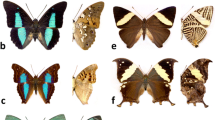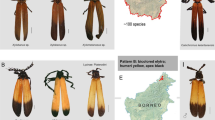Abstract
The extensive wing pattern diversity observed among sympatric unpalatable mimetic butterflies is difficult to explain. Diversity is a paradox because selection by predators is expected to drive local species to use the same aposematic patterns. Habitat segregation among mimicry complexes has been suggested as a hypothesis to explain how diversity could be maintained. However, very few studies have tested this hypothesis. To test whether mimicry complexes are associated with particular habitats, I sampled a diverse assemblage of ithomiine butterflies from eastern Ecuador comprising nine discrete mimicry complexes. Butterflies were sampled in four habitats varying along a gradient of succession. A total of 43 species and 902 individuals were sampled. Ithomiine species richness and abundance were lowest in open habitats, and habitat preferences were documented for many species. Mimicry complexes exhibited significant habitat differences supporting the role of habitat segregation in maintaining mimetic diversity. However, there was obvious overlap among mimicry complexes, particularly involving the two numerically dominant patterns at the site. The pattern of segregation appears to be driven by common species, with relatively little evidence that the distribution of rarer species matches that of the more abundant species. Thus, habitat segregation is likely to play a role in the evolution of mimetic diversity as a result of segregated abundant model species, but the effect is probably weak and other factors are also important.



Similar content being viewed by others
References
Beccaloni GW (1997a) Ecology, natural history and behaviour of ithomiine butterflies and their mimics in Ecuador (Lepidoptera: Nymphalidae: Ithomiinae). Trop Lepid 8:103–124
Beccaloni GW (1997b) Vertical stratification of ithomiine butterfly (Nymphalidae: Ithomiinae) mimicry complexes: The relationship between adult flight height and larval host-plant height. Biol J Linn Soc Lond 62:313–341
Brower AVZ, Freitas AVL, Lee MM et al (2006) Phylogenetic relationships among the Ithomiini (Lepidoptera: Nymphalidae) inferred from one mitochondrial and two nuclear gene regions. Syst Entomol 31:288–301. doi:10.1111/j.1365-3113.2006.00321.x
Brown KS Jr (1979) Ecologia geografica e evolucao nas florestas neotropicas. Universidade Estadual de Campinas, Livre de Docencia., Campinas, Brazil
Brown KS Jr (1984a) Adult-obtained pyrrolizidine alkaloids defend ithomiine butterflies against a spider predator. Nature 309:707–709. doi:10.1038/309707a0
Brown KS Jr (1984b) Chemical ecology of dehydropyrrolizidine alkaloids in adult Ithomiinae. Rev Bras Biol 44:435–460
Brown KS Jr, Benson WW (1974) Adaptive polymorphism associated with multiple Müllerian mimicry in Heliconius numata (Lepidoptera, Nymphalidae). Biotropica 6:205–228. doi:10.2307/2989666
Brown KS Jr, Sheppard PM, Turner JRG (1974) Quaternary refugia in tropical America: evidence from race formation in Heliconius butterflies. Proc R Soc Lond B Biol Sci 187:369–378
Burd M (1994) Butterfly wing colour patterns and flying heights in the seasonally wet forest of Barro Colorado Island, Panama. J Trop Ecol 10:601–610
Colwell RK, Coddington JA (1994) Estimating terrestrial biodiversity through extrapolation. R Soc Philos Trans Biol Sci 345:101–118. doi:10.1098/rstb.1994.0091
DeVries PJ, Walla TR (2001) Species diversity and community structure in neotropical fruit-feeding butterflies. Biol J Linn Soc Lond 74:1–15. doi:10.1111/j.1095-8312.2001.tb01372.x
DeVries PJ, Lande R, Murray D (1999a) Associations of co-mimetic ithomiine butterflies on small spatial and temporal scales in a neotropical rainforest. Biol J Linn Soc Lond 67:73–85. doi:10.1111/j.1095-8312.1999.tb01930.x
DeVries PJ, Walla TR, Greeney H (1999b) Species diversity in spatial and temporal dimensions of fruit-feeding butterflies from two Ecuadorian rainforests. Biol J Linn Soc Lond 68:333–353. doi:10.1006/bijl.1999.0319
Elias M, Hill RI, Willmott KR et al (2007) Limited performance of DNA barcoding in a diverse community of tropical butterflies. Proc Royal Soc B: Biol Sci 274:2881–2889
Estrada C, Jiggins CD (2002) Patterns of pollen feeding and habitat preference among Heliconius species. Ecol Entomol 27:448–456. doi:10.1046/j.1365-2311.2002.00434.x
Heck KL, van Bell G, Simberloff D (1975) Explicit calculation of the rarefaction diversity measurement and the determination of sufficient sample size. Ecology 56:1459–1461. doi:10.2307/1934716
Hill RI (2006) Life history and biology of Forbestra olivencia (Bates, 1862) (Nymphalidae, Ithomiinae). Journal of the Lepidopterists’. Society 60:203–210
Hill RI, Tipan L (2008) Description of the immature stages of Methona confusa confusa Butler, 1873 and Methona curvifascia Weymer, 1883 (Nymphalidae, Ithomiinae) from eastern Ecuador Journal of the Lepidopterists’. Society 62:89–98
Jiggins CD, Mallarino R, Willmott KR et al (2006) The phylogenetic pattern of speciation and wing pattern change in Neotropical Ithomia butterflies (Lepidoptera: Nymphalidae). Evolution Int J Org Evolution 60:1454–1466
Joron M (2005) Polymorphic mimicry, microhabitat use, and sex-specific behaviour. J Evol Biol 18:547–556. doi:10.1111/j.1420-9101.2005.00880.x
Joron M, Mallet JLB (1998) Diversity in mimicry: paradox or paradigm. Trends Ecol Evol 13:461–466. doi:10.1016/S0169-5347(98)01483-9
Kronforst MR, Gilbert LE (2007) The population genetics of mimetic diversity in Heliconius butterflies. Proc Royal Soc B-Biol Sci 275:493–500. doi:10.1098/rspb.2007.1378
Lamas G (ed) (2004) Atlas of Neotropical lepidoptera—checklist: part 4A Hesperioidea—Papilionoidea. Scientific Publishers, Gainesville, FL
Mallet J (1986) Hybrid zones in Heliconius butterflies in Panama and the stability and movement of warning color clines. Heredity 56:191–202. doi:10.1038/hdy.1986.31
Mallet J (1993) Speciation, raciation, and color pattern evolution in Heliconius butterflies: evidence from hybrid zones. In: Harrison RG (ed) Hybrid zones, the evolutionary process. Oxford University Press, New York, pp 226–260
Mallet J, Gilbert LE (1995) Why are there so many mimicry rings? Correlations between habitat, behaviour and mimicry in Heliconius butterflies. Biol J Linn Soc Lond 55:159–180
Mallet J, Joron M (1999) Evolution of diversity in warning color and mimicry: polymorphisms, shifting balance and speciation. Annu Rev Ecol Syst 30:201–233. doi:10.1146/annurev.ecolsys.30.1.201
Mallet J, Singer MC (1987) Individual selection, kin selection, and the shifting balance in the evolution of warning colours: the evidence from butterflies. Biol J Linn Soc Lond 32:337–350. doi:10.1111/j.1095-8312.1987.tb00435.x
Medina MC, Robbins RK, Lamas G (1996) Vertical stratification of flight by ithomiine butterflies at Pakitza, Manu National Park, Peru. In: Wilson DE, Sandoval A (eds) Manu, the biodiversity southeastern Peru. Smithsonian Institution, Washington, DC, pp 211–216
Müller F (1879) Ituna and Thyridia; a remarkable case of mimicry in butterflies (translated by R Meldola). Proc Royal Entomol Soc London 1879:xx-xxix
Papageorgis C (1975) Mimicry in Neotropical butterflies. Am Scientist 63:522–532
Poole RW (1970) Habitat preferences of some species of a Müllerian-mimicry complex in northern Venezuela, and their effects on evolution of mimic-wing pattern. J NY Entomol Soc 78:121–129
Sheppard PM, Turner JRG, Brown KS Jr et al (1985) Genetics and the evolution of muellerian mimicry in Heliconius butterflies. Philos Trans R Soc Lond B Biol Sci 308:433–613. doi:10.1098/rstb.1985.0066
Srygley RB (1999) Locomotor mimicry in Heliconius butterflies: contrast analyses of flight morphology and kinematics. Philos Trans R Soc Lond B Biol Sci 354:203–214. doi:10.1098/rstb.1999.0372
Srygley RB, Ellington CP (1999) Discrimination of flying mimetic, passion-vine butterflies Heliconius. Proc R Soc Lond B Biol Sci 266:2137–2140. doi:10.1098/rspb.1999.0899
Turner JRG (1976) Muellerian mimicry: classical ‘beanbag’ evolution and the role of ecological islands in adaptive race formation. In: Karlin S, Nevo E (eds) Population genetics and ecology. Academic Press, New York, pp 185–218
Turner JRG (1983) Mimetic butterflies and punctuated equilibria: some old light on a new paradigm. Biol J Linn Soc Lond 20:277–300. doi:10.1111/j.1095-8312.1983.tb01877.x
Turner JRG (1984) Mimicry: the palatability spectrum and its consequences. In: Vane-Wright RI, Ackery PR (eds) The biology of butterflies. Academic Press, London
Turner JRG, Mallet JLB (1996) Did forest islands drive the diversity of warningly coloured butterflies? Biotic drift and the shifting balance. Philos Trans R Soc Lond B Biol Sci 351:835–845. doi:10.1098/rstb.1996.0078
Vasconcellos-Neto J (1986) Interactions between Ithomiinae (Lepidoptera: Nymphalidae) and Solanaceae. In: D’Arcy WG (ed) Solanaceae: biology and systematics. Columbia University Press, New York, pp 364–377
Vasconcellos-Neto J, Lewinsohn TM (1984) Discrimination and release of unpalatable butterflies by Nephila clavipes, a neotropical orb-weaving spider. Ecol Entomol 9:337–344. doi:10.1111/j.1365-2311.1984.tb00857.x
Willmott KR, Freitas AVL (2006) Higher-level phylogeny of the Ithomiinae (Lepidoptera: Nymphalidae): classification, patterns of larval hostplant colonization and diversification. Cladistics 22:297–368. doi:10.1111/j.1096-0031.2006.00108.x
Willmott KR, Mallet J (2004) Correlations between adult mimicry and larval host plants in ithomiine butterflies. Proc R Soc Lond B Biol Sci 271:S266–S269. doi:10.1098/rsbl.2004.0184
Acknowledgments
This work was supported by fellowships from the UC Berkeley Department of Integrative Biology, Section of Integrative Biology and Institute for Latin American Studies at UT Austin, Explorers Club, Sigma Xi and Society of Integrative and Comparative Biology. Thank you to the communities of Sani Isla and Pilche, and the management and staff of La Selva Jungle Lodge for facilitating this work, and to the Museo Ecuatoriano de Ciencias Naturales in Quito for help obtaining research permits. Thanks to M. deVries and M. Medeiros for reading early drafts, and to P. J. DeVries, R. Dudley, R. Gillespie, M. Kronforst, J. McGuire and two anonymous reviewers for constructive comments on the manuscript.
Author information
Authors and Affiliations
Corresponding author
Rights and permissions
About this article
Cite this article
Hill, R.I. Habitat segregation among mimetic ithomiine butterflies (Nymphalidae). Evol Ecol 24, 273–285 (2010). https://doi.org/10.1007/s10682-009-9305-5
Received:
Accepted:
Published:
Issue Date:
DOI: https://doi.org/10.1007/s10682-009-9305-5




